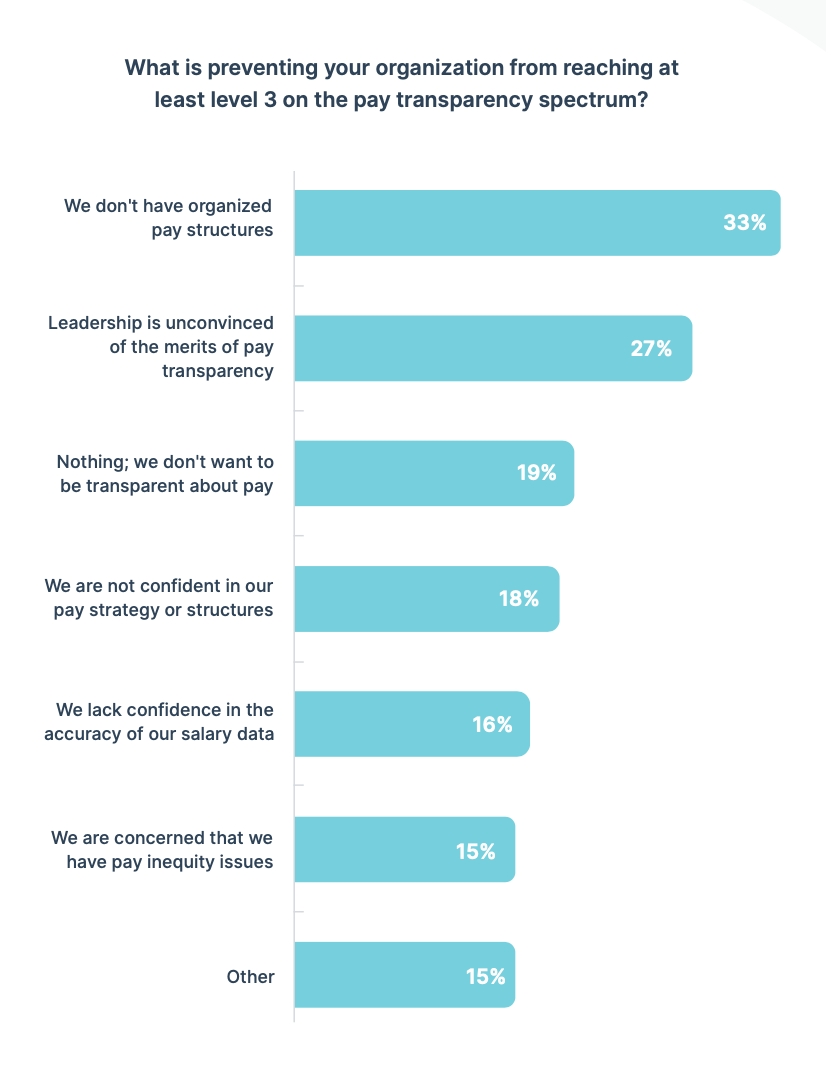Many employers don’t buy into pay transparency, study finds
While more companies are offering pay ranges in their job postings, many are doing it begrudgingly. Many others don’t even see a reason why.
A new Payscale survey found that 45% of employers now include that salary information in job ads, more than double the number (22%) that did a year ago. But 18% of those only do it when they are required by law, according to the report.
Similarly distressing: Over a quarter of firms surveyed said that leadership is unconvinced of the merits of pay transparency and a fifth say they don’t want to be transparent. One in 9 organizations say they are resisting pay transparency altogether.
The results come as state and local laws requiring pay disclosures gain momentum with legislation in California and Washington state going into effect Jan. 1 and a similar one following later this year in New York state. Comparable pay disclosure laws are already in place in Colorado and New York City, while Maryland and Rhode Island require salary information to be provided when an applicant requests it.
Still “most employers do not appear to be ready for pay transparency laws,” Ruth Thomas, pay equity strategist at Payscale, told Yahoo Finance, even though by the end of this year, roughly 1 in 4 workers will be covered by a state or local law that requires businesses to be transparent about their pay ranges, a development that can have many advantages for workers.
Resisting revealing salary ranges
Even the companies who are bowing to the legal requirements are not always doing so in full spirit of the law. The biggest shortcoming so far of new state salary transparency laws is laughably wide pay ranges, often covering more than a six-figure span.

And it is not just in job postings where employers prefer to keep salaries hidden. Disappointingly, a tiny fraction (13%) of organizations don’t share pay ranges with employees at all, at any point in the employment process, according to Payscales’s report.
“Many organizations fear adding pay ranges to job ads because they suspect it will lead to discontent in the current workforce,” Thomas said. “Employees might discover these posts and find that they are paid lower on the advertised range–or below the range–than they might expect or feel entitled to. Often, the hang-up around pay transparency is a lack of internal pay equity or a lack of confidence in salary data or pay structures.”
Just a little over half of organizations (55%) reported they have a compensation strategy, up 7% since last year, according to Payscale.“This is critical because a compensation strategy is required for building formal pay structures and complying with pay transparency legislation,” Thomas said.
Admittedly, rolling out pay transparency is a process. “It's going to take time for companies to develop a pay philosophy and a disciplined pay system and procedures,” Julia Pollak, chief economist at ZipRecruiter, the employment search site, told Yahoo Finance.

Sooner rather than later is a good strategy, however, for firms scrambling to fill job openings.
“This generation of students and upcoming graduates are hungry for transparency from employers,” Valerie Capers Workman, chief legal officer at Handshake, told Yahoo Finance. “Our latest Handshake Network Trends report saw that Gen Z is prioritizing stability, a competitive salary, and benefits — and from what I’ve seen, they’re very comfortable with talking about all three.”
In a previous Handshake Network Trends report, respondents “overwhelmingly cited a clear ‘salary range’ on a job description as the greatest motivator when applying to a position,” according to Workman.
“Pay transparency enables them to determine their value, get an idea of what income could look like, set budgets and expectations, and plan for their futures accordingly,” Workman said.
And since employers are clearly still dancing to keep up with resignations, that matters.
“While cooling somewhat last year, the job quitting rate is still 16% above the pre-pandemic norm as employed workers continue to find new work at elevated rates,” Nick Bunker, head of economic research for Indeed Hiring Lab, told Yahoo Finance.
“Some sectors are going through difficult periods, but demand to hire new workers remains robust,” Bunker said. “If competition for new hires doesn’t moderate more, employers will need to attract workers through higher wages, more generous benefits, or more flexible work arrangements.”
Moreover, pay transparency is essential to narrowing the gender pay gap and advancing equity in the workforce, Workman added. Last year, women earned an average of 82% of what men earned, according to a new analysis of median hourly earnings of both full-and-part-time workers by the Pew Research Center published this week. In 2002, women earned 80% as much as men.
“The gender pay gap starts even before women enter the workforce. In fact, it begins as early as when salary expectations are communicated. We’re seeing that with this graduating class. Our survey shows that Gen Z women expect a $6,200 lower average salary compared to men,” she said. “This is consistent for women across all racial and ethnic groups.”
Kerry is a Senior Reporter and Columnist at Yahoo Finance. Follow her on Twitter @kerryhannon.
Read the latest financial and business news from Yahoo Finance
Download the Yahoo Finance app for Apple or Android
Follow Yahoo Finance on Twitter, Facebook, Instagram, Flipboard, LinkedIn, and YouTube.
